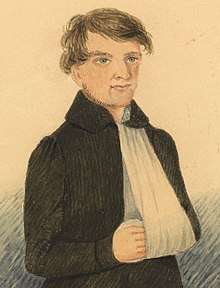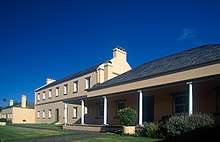Lawrence Kavenagh
Lawrence Kavenagh (c. 1805 – 13 October 1846) was a convict bushranger known for escaping from Port Arthur, Van Diemen's Land (the so-called escape proof colony), with Martin Cash and George Jones.
Lawrence Kavenagh | |
|---|---|
 Portrait of a man thought to be Kavanagh, c. 1843 | |
| Born | 1805 Waterford, Ireland |
| Died | 13 October 1846 |
| Conviction(s) | Murder |
| Criminal penalty | Hanged |
Transportation
Born in Waterford, Ireland, he was convicted for burglary and sentenced to penal transportation for life. He arrived on the Ferguson in 1829 at Sydney. In 1837 he had his Ticket of leave cancelled after dishonest conduct.[1] After committing many offences he was sent to Norfolk Island where he received a total of 180 lashes for insolence and attempted escape. In 1842 he escaped and returned to Sydney. There Kavenagh fired on two men who recognized him while on the run. He was captured and sentenced to Port Arthur for attempted murder.

Cash & Co
On 26 December 1842 Lawrence Kavenagh, Martin Cash and George Jones absconded from a work party. Hiding in dense scrubland and with little food they made their way 15 km to the neck. Swimming with their clothes tied in bundles above their heads, they made it to the other side but all three of them lost their bundles. Now naked, the trio robbed a road gang's hut for clothing, and began a seven month spree of bushranging and robbing mail coaches, homesteads and inns.
In July 1843, the Government offered 'one hundred acres of land or one hundred sovereigns, in addition to the reward of fifty sovereigns, free pardon, and passage from the colony, for the apprehension of' Cash, Jones and Kavenagh.[2][3]
On 10 July 1843 Kavenagh gave himself up after wounding himself that morning, at Lake Sorell, by the accidental discharge of his own gun while getting over a log. He claimed he walked 28 miles to Bothwell in great pain when he surrendered. He had shot himself in the arm. He said he had to give himself up or he would bleed to death in the bush.[4]
He was tried on 4 September 1843, before Justice Montagu, found guilty, and sentenced to death.[5][6] But the sentence was commuted by the Lieutenant-Governor Sir John Eardley-Wilmot,[5] and Kavenagh was sent to Norfolk Island.[6]
Norfolk Island
He got caught up with the Cooking pot uprising, joining a large group in a mutiny that led to the murder of an overseer, a gatekeeper and two constables.[7]
Lawrence Kavenagh was hanged with 11 others on 13 October 1846.[8] He was buried on Norfolk Island and is discussed on the island's tours.
References
- https://trove.nla.gov.au/newspaper/article/230670982?searchTerm=Lawrence%20kavenagh&searchLimits=l-decade=183
- "Domestic Intelligence". Colonial Times. Hobart, Tas.: National Library of Australia. 11 July 1843. p. 3. Retrieved 18 December 2013.
- "REWARD of One Hundred Acres of Land, or One Hundred Sovereigns!". The Courier. Hobart, Tas.: National Library of Australia. 14 July 1843. p. 4. Retrieved 18 December 2013.
- https://trove.nla.gov.au/newspaper/article/8753749?searchTerm=cash%20jones%20kavenagh&searchLimits=l-decade=184
- Edited by Hamar Foster; Benjamin L. Berger; A.R. Buck. The Grand Experiment: Law and Legal Culture in British Settler Societies. UBC Press. p. 168. ISBN 978-0-7748-5855-7.CS1 maint: extra text: authors list (link)
- "GENERAL GAOL DELIVERY". The Courier. Hobart, Tas.: National Library of Australia. 8 September 1843. p. 2. Retrieved 18 December 2013.
- "Norfolk Island". The Courier. Hobart, Tas.: National Library of Australia. 2 September 1846. p. 2. Retrieved 18 December 2013.
- "Norfolk Island". The Courier. 28 October 1846. p. 3. Retrieved 24 February 2013.
... sentenced to die, were ... and Lawrence Kavenagh, the associate of Cash and Jones in this colony. The twelve men found guilty of the riots and murders were executed on the morning of Tuesday, October 13. Six of them expiated their offences on the scaffold at eight in the morning, and the other six at ten o'clock on the same day
.
- "Bio of Lawrence Kavanagh". Retrieved 10 January 2006.
- "Trial of Lawrence Kavenagh". Retrieved 10 January 2006.